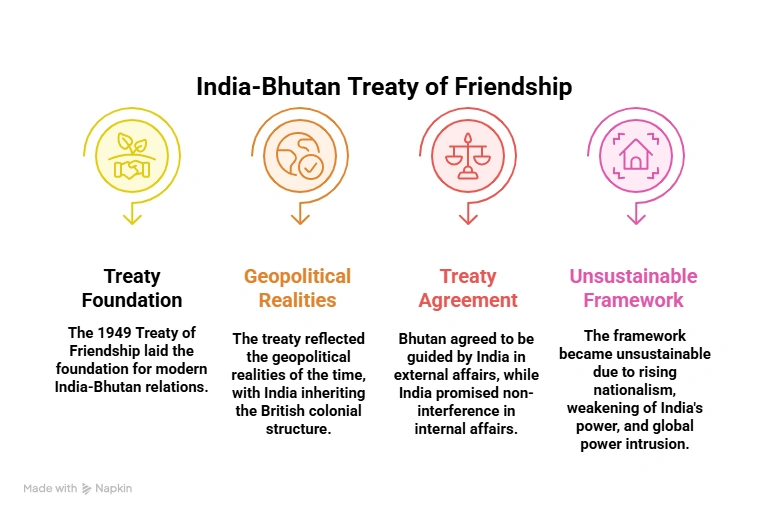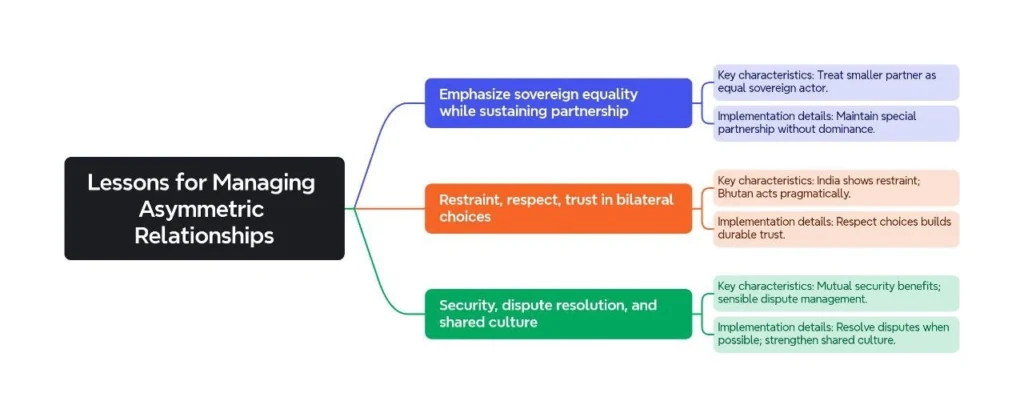Paper: GS – II, Subject: International Relations, Topic: India and its Neighbourhood, Issue: India-Bhutan Relations.
Context:
The India-Bhutan relationship is a unique example of a successful and enduring partnership between two countries with vast differences in size and power.
Key Highlights:
- The relationship has evolved significantly over time, adapting to changing geopolitical realities and the internal dynamics of both nations.

Transition and Adaptation:
- While the protectorate model collapsed in Nepal and Sikkim, Bhutan managed the transition with remarkable suppleness.
- Bhutan steadily expanded its strategic autonomy without engaging in persistent confrontation with India or being absorbed by it.
- The maturity of leadership in both countries and their recognition of shared strategic stakes ensured broad political stability.
- India helped Bhutan build its administrative institutions, train its armed forces, and develop its economy.
- Hydropower cooperation, launched in the 1960s, became the central pillar of Bhutan’s growth and a symbol of mutually beneficial economic partnership.
- India learned to resist the temptation to deal with Bhutan with a heavy hand.
Navigating the Regional Landscape:
- Bhutan, like all of India’s neighbors, is navigating a strategic landscape transformed by China’s ascent.
- Sharing a long and disputed border with China and occupying a sensitive location in the eastern Himalayas, Bhutan faces unique challenges.
- Bhutan has no formal diplomatic ties with Beijing, but the two sides hold regular consultations to resolve their boundary dispute.
- The Doklam plateau, the scene of the 2017 India-China standoff, remains a critical flashpoint.
- Even as Bhutan diversifies, it has deepened ties with India through new hydropower projects, cross-border railway links, digital initiatives, and educational cooperation.
Lessons for Managing Asymmetric Relationships:

India’s experience with Bhutan exemplifies how large and small neighbors can maintain constructive, resilient relationships through respect, cooperation, and strategic patience.
La Excellence IAS Academy, the best IAS coaching in Hyderabad, known for delivering quality content and conceptual clarity for UPSC 2025 preparation.
FOLLOW US ON:
◉ YouTube : https://www.youtube.com/@CivilsPrepTeam
◉ Facebook: https://www.facebook.com/LaExcellenceIAS
◉ Instagram: https://www.instagram.com/laexcellenceiasacademy/
GET IN TOUCH:
Contact us at info@laex.in, https://laex.in/contact-us/
or Call us @ +91 9052 29 2929, +91 9052 99 2929, +91 9154 24 2140
OUR BRANCHES:
Head Office: H No: 1-10-225A, Beside AEVA Fertility Center, Ashok Nagar Extension, VV Giri Nagar, Ashok Nagar, Hyderabad, 500020
Madhapur: Flat no: 301, survey no 58-60, Guttala begumpet Madhapur metro pillar: 1524, Rangareddy Hyderabad, Telangana 500081
Bangalore: Plot No: 99, 2nd floor, 80 Feet Road, Beside Poorvika Mobiles, Chandra Layout, Attiguppe, Near Vijaya Nagara, Bengaluru, 560040
